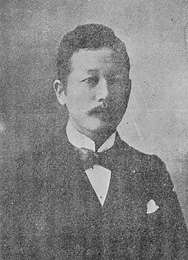Yamaza Enjirō
Yamaza Enjirō (山座円次郎, December 2, 1866 – May 28, 1914) was a Japanese diplomat in Meiji period Japan.[1]
Yamaza Enjirō 山座円次郎 | |
|---|---|
 Portrait of Yamaza Enjirō | |
| Born | December 2, 1866 |
| Died | May 28, 1914 (aged 47) |
| Nationality | Japanese |
| Occupation | diplomat |
Early life
Yamaza was born in Fukuoka, as the son of a samurai of the lowest rank (ashigaru), affiliated with the Fukuoka Domain.[1]
In 1892, he attended the Law College of the Tokyo Imperial University, where his follow classmates included Natsume Sōseki, Masaoka Shiki, Akiyama Saneyuki and Minakata Kumagusu.
Career
Yamaza's work in Japan's Foreign Ministry led to appointments as part of the resident staff in at the Japanese consulates in Pusan and Incheon in Korea. Following an appointment to the Japanese embassy in London,[1] he was appointed chargé d'affairs in Seoul in February 1901.[2]
Back in Tokyo, Yamaza was promoted as the Director of the Political Affairs Bureau within the Foreign Ministry in 1901.[3] Working with Foreign Minister Komura Jutarō, Enjiro was involved in forging the Anglo-Japanese Alliance. He was also involved in negotiations with the Empire of Russia and diplomacy preceding the Russo-Japanese War. Some scholarly researchers credit Yamaza with drafting the text of the Japanese Declaration of War.[4]
Yamaza was part of the Japanese delegation which negotiated the Treaty of Portsmouth.[1] In this context, some Korean scholars assert that Yamaza played a notable role in calling for incorporation of Liancourt Rocks within Japanese territorial claims.[5]
In 1908, Yamaza was councillor of the Japanese embassy in Great Britain, with responsibility for planning of Japan's participation in the London Naval Conference (1908–1909) and the Japan–British Exhibition in 1910.[6]
In 1913, Yamaza was appointed Japan's minister to China, which was then in the midst of the Xinhai Revolution. Yamaza was a supporter of Sun Yat-sen, which earned him the enmity of the powerful Yuan Shikai.[7] Yamaza died of unknown causes in Beijing in 1914.[1] His grave is at the Aoyama Cemetery in Tokyo.
See also
- List of Ambassadors from Japan to South Korea
References
- National Diet Library: Portrait, Enjiro Yamaza
- Korean Mission to the Conference on the Limitation of Armament, Washington, D.C., 1921–1922. (1922).Korea's Appeal to the Conference on Limitation of Armament, p. 34., p. 34, at Google Books
- "Our Japanese Allies," The Argus (Melbourne, Victoria, Australia). September 25, 1908, p. 5.
- Naval Postgraduate School (US) thesis: Na, Sang Hyung. "The Korean-Japanese Dispute over Dokdo/Takeshima," p. 62 n207 December 2007, citing Byang-Ryull Kim. (2006). Ilbon Gunbu'ui Dokdo Chim Talsa (The Plunder of Dokdo by the Japanese Military), p. 121.
- Na, p. 62 n208; and see Northeast Asian History Foundation: Kim Hwa-gyeong. "Calling on Japan for its Firm Resolve."
- Hotta-Lister, Ayako. (1999). The Japan-British Exhibition of 1910: Gateway to the Island Empire of the East, pp. 47–48., p. 47, at Google Books
- Jansen p. 164
Further reading
- Hotta-Lister, Ayako, The Japan-British Exhibition of 1910: gateway to the island empire of the East Richmond, Surrey: Japan Library, 1999. ISBN 1-873410-88-3
- Korean Mission to the Conference on the Limitation of Armament, Washington, D.C., 1921–1922. (1922). Korea's Appeal to the Conference on Limitation of Armament. Washington: U.S. Government Printing Office. OCLC 12923609
- Jansen, Marius B. (1954).The Japanese and Sun Yat-sen. Cambridge: Harvard University Press. OCLC 412532
External links
- National Diet Library, Portraits of Modern Japanese Historical Figures, Yamaza Enjiro